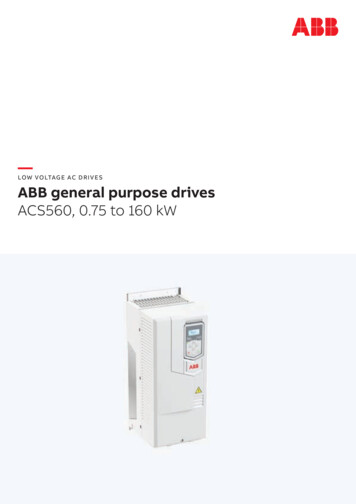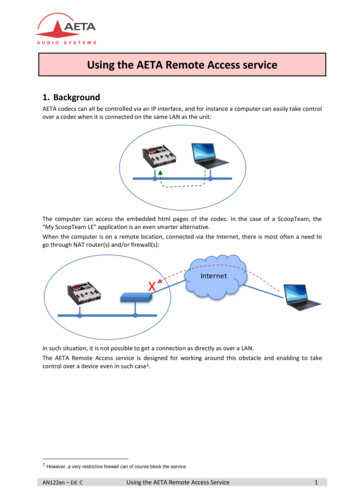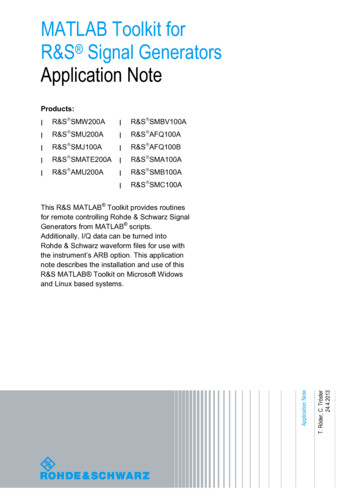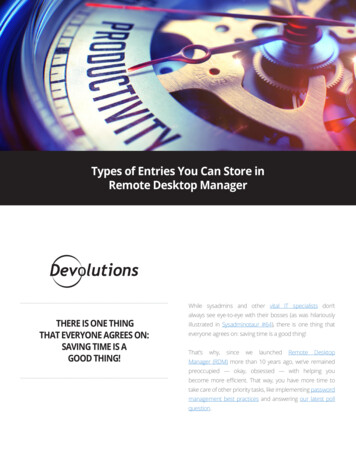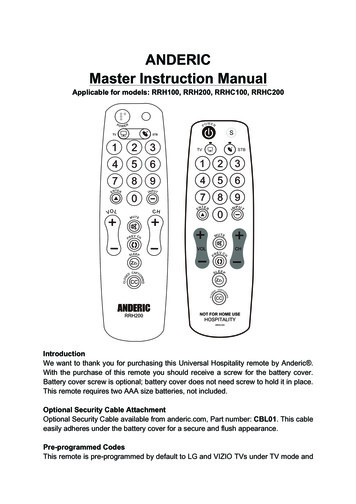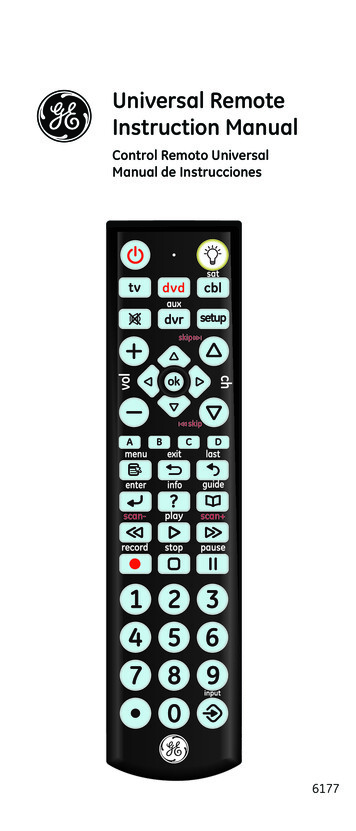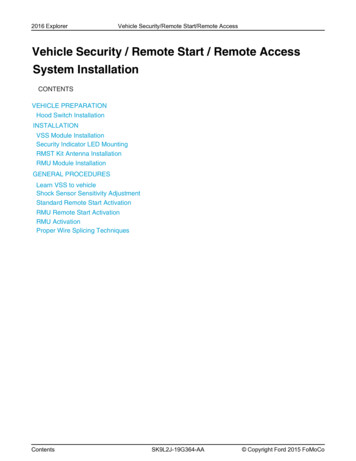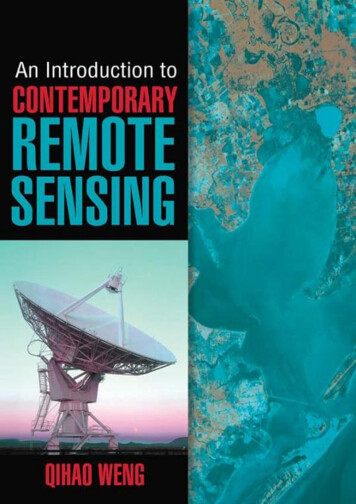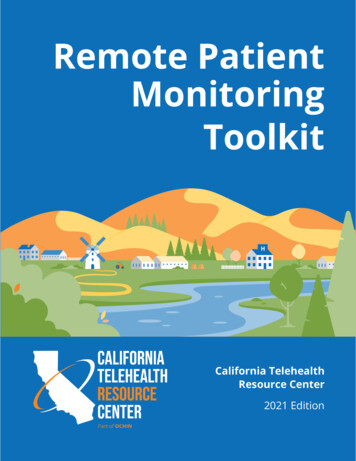
Transcription
Remote PatientMonitoringToolkitHCalifornia TelehealthResource Center2021 Edition
CTRC 2021The California Telehealth Resource Center (CTRC), and resources and activities produced or supported by theCTRC, are made possible by grant number GA5RH37469 from the Office for the Advancement of Telehealth,Health Resources and Services Administration, DHHS. The information or content and conclusions herein arethose of the CTRC. They should not be construed as the official position or policy of HRSA, HHS or the U.S.Government. No official endorsements of any kind, by any of these entities, should be inferred.
Remote Patient Monitoring ToolkitTable of ContentsCTRC Remote Patient Monitoring Toolkit. 1How to Use this Toolkit. 2Folio 1: Introduction & Overview.5What is Remote Patient Monitoring?. 5RPM Helps Practices Achieve the Quadruple Aim. 5RPM Data Collected in the Course of Daily Living: A Fuller Picture of Patient Health. 6RPM for Timely, Precision, Cost-Effective Care. 6RPM Boosts Patient Engagement and Satisfaction. 7RPM Can Expand Health Equity in the Safety Net. 7Conclusion . 8Folio 2: Build Your Team.9Designate an RPM Coordinator. 10Responsibilities of the RPM Coordinator. 10Stakeholders, Champions, and a Core Group of Change Leaders . 11Explain Why RPM is Right for Your Health Center. 13Folio 3: Assess, Plan, & Identify Clinical Use Cases.14Approach RPM in Phases. 14Take Stock of Where You Are Now: Assess Needs and Readiness. 14H
Remote Patient Monitoring ToolkitScan the Environment for Key Considerations. 16RPM Data Security and Privacy. 17Obtain HIPAA Business Associate Agreements (BAAs) with RPM Vendors. 17Identify Best Practices to Protect RPM Data. 18Provide Staff with Standardized Scripts for Patient Education. 18Create Patient Education on Data Security and Fold into RPM Patient Training. 18Current Clinical Use Cases Can Point to Areas of Need. 19Considerations: RPM Devices . 20RPM Devices Compatible with Your EHR. 20Data Frequency and Volume. 21RPM Tools Include FDA-approved Devices and Consumer Products. 21RPM Devices Required for Payor Reimbursement. 21Build a Digital Formulary. 21Digital Formulary or BYOD?. 22Next Steps. 22Folio 4: Test, Refine, Iterate, Repeat .24Frameworks to Structure Pilot Testing and Implementation . 24Capture Baseline Data. 25Start Small with Your Simplest Clinical Use Case. 26Policies, Protocols, Workflows . 27H
Remote Patient Monitoring ToolkitDesign Policies and Workflows to Reduce Clinician Burnout. 28Map Workflows: Swimlane Diagrams. 30Rapid-Cycle Tests of Change and End-User Feedback . 32Folio 5: Grow Your RPM Program.33Rely on Clinician Champions to Lead Training and Communications Efforts. 33For Vivid, Relatable Materials, Fold in Learnings from Pilot Testing . 34Explore Training Resources from Vendors and Community Partners. 34Two Communications Plans: One for Staff and One for Patients. 34What are the Priorities of Your Target Audiences?. 35Use Consistent Messaging and Graphics. 35Call to Action: What are Measurable Goals for Your Campaigns?. 36Incentivize Staff and Patients to Reach Campaign Goals. 37Training and Technical Support. 37Staff Training: Start with the Rationale for RPM. 38Offer Multiple Ways for Staff to Learn. 39Initial Close Monitoring and Feedback is Critical for Success . 40Bring RPM Devices to Office Appointments. 40RPM Program Maintenance and Sustainability. 41Folio 6: Resources.43Key Terms and Concepts. 43H
Remote Patient Monitoring ToolkitResources. 45Community Resources. 45RPM Devices and Applications. 46RPM Policy. 47RPM Data Privacy and Security. 47RPM Reimbursement. 48Operational Resources. 48References. 49H
Remote Patient Monitoring ToolkitABOUT CTRCThe California Telehealth Resource Center (CTRC) offers no-cost, unbiased training,educational resources, and technical assistance to help California providers and patientsget the most from telehealth. As the federally designated telehealth resource center forthe region, we offer unbiased tools and services based upon proven telehealth practices.We create lasting change and improvement by focusing on implementation, sustainability,reimbursement and policy, integration, workflows, and patient/provider adoption.As part of the National Consortium of Telehealth Resource Centers and the OCHIN familyof companies, CTRC assists thousands of providers and patients annually. We haveextensive experience supporting the health care safety net, rural and urban providers,and patients and families throughout California who would otherwise be unable toaccess quality health care due to geographic isolation, language/cultural barriers, lack ofinsurance, disability, homelessness, and more.CTRC Remote Patient Monitoring ToolkitAs health care moves from a fee-for-service model to a value-based approach thatrewards performance and outcomes, remote patient monitoring is helping to acceleratethe transition from episodic, reactive care delivered in clinical settings to a continuous,proactive model that blends virtual and in-clinic care.Patients can use medically-prescribed RPM devices in the course of everyday activities tocollect and transmit biometric data such as blood pressure readings, blood glucose levels,body weight, heart rate, respiration, and temperature directly into the electronic healthrecord (EHR) in near-real time.These data sets give a detailed and nuanced view of the state of the patient’s healthas values fluctuate over hours, days, and weeks, enabling providers to deliver morepersonalized care characterized by frequent minor adjustments. Subtle changesin the data can trigger interventions sooner in lower-cost settings, supporting theQuadruple Aim. 1We are poised at the edge of a new era in medicine that applies machine learning, AI,predictive analytics, and other emerging technologies to bodies of RPM data to unlockuntapped potential to describe clinical phenotypes, create more sensitive diagnosticindicators, and develop more personalized treatments. It is technology that fits well into a CTRC 2021H1
Remote Patient Monitoring Toolkitvalue-based system that rewards performance and outcomes.This toolkit is intended to help California providers and patients optimize RPM for better,more equitable care. Practices that embrace RPM technologies today, will be wellpositioned to leverage eminent powerful advances that build on RPM to transform care aswe know it.How to Use this ToolkitDivided across six searchable folios, find basic definitions, key considerations, andstepwise processes to tailor an RPM program to the needs of your unique practice. Folioscan be used sequentially or as free-standing references for various RPM topics.To search each folio using keywords, press CONTROL F on your keyboard (COMMAND F for Mac).Print out each folio and use pen and paper to make notes in the provided spaces or usefree Adobe Acrobat Reader software to type directly into the document.1Click on “Fill & Sign.”2Put cursor anywhere in the folio.3Start typing.4Click out of the text box. Edit anytime.If you need assistance with any of the content presented in this toolkit, please click here. CTRC 2021H2
Remote Patient Monitoring ToolkitFolio 1: Introduction and Overview Introduction and Overview of RPM and basic definitions Intent of the toolkit How to use the toolkitFolio 2: Build Your Team Identify stakeholders, champions, and a core groupInvolve stakeholders early in decision-makingThe essential role of clinical championsDescribe why RPM makes sense for your health centerFolio 3: Assess, Plan, and Identify Clinical Use Cases Assess provider/organizational/patient readinessDescribe unmet needs RPM might addressScan the environment for key considerationsMatch clinical use cases for RPM to your health center’s needsChoose appropriate RPM devices and dispensing modelsFolio 4: Test, Refine, and Implement Use Change management and QI frameworksEstablish baseline measures for your health centerSet a measurable goalCreate policy and protocolMap workflowSelect good candidates for pilot testingTest processes with your simplest use case and limited cohortIteratively refine based on data and user feedback CTRC 2021H3
Remote Patient Monitoring ToolkitFolio 5: Grow Your RPM Program Communication campaigns Internal campaign directed at staff External campaign directed at patients Training program Staff training and onboarding new roles Patient training and technical support Fold in offerings from vendors Leverage champions to tout RPM benefits and teach the skillsFolio 6: Glossary and Resources CTRC 2021H4
Remote Patient Monitoring ToolkitHFOLIO 1:Introduction& OverviewWhat is Remote Patient Monitoring?Remote patient monitoring (RPM) uses connected digital tools in the places people live,work, and play to electronically capture and transmit an individual’s health and medicaldata for review by a provider in a separate location from the patient. 2Examples of RPM devices include: Heart monitorsBody weight scalesBlood pressure cuffsGlucometersPulse oximetersThermometersWhen RPM data is integrated into the EHR, it is quickly available for the provider to review,and can be used for clinical decision-making.RPM Helps Practices Achieve the Quadruple AimRPM helps practices achieve the Quadruple Aim. 1 It has been demonstrated to increasesatisfaction, improve health outcomes, and reduce costs. 3 RPM can potentially generatestreams of data between office visits. Slight changes or abnormal values can flagproviders to make small adjustments to the care plan or deploy interventions early in adisease process, preempting a trip to the emergency room or admission to the hospital. CTRC 20215
Remote Patient Monitoring ToolkitFolio 1: Introduction & OverviewThis illustrates how RPM-enabled care supports the Quadruple Aim: Improved health outcomesGreater patient satisfactionReduced provider burden/increased provider satisfactionCost-effectivenessRPM Data Collected in the Course of Daily Living:A Fuller Picture of Patient HealthRPM data collected between in-office visits by patients in the course of everyday livingprovide a fuller picture of patient health for longitudinal, continuous care. For example,home blood pressure readings can supplement those recorded in the clinical setting todevelop, track, and finely adjust a personalized hypertension control treatment plan forimproved health outcomes. 4 5RPM for Timely, Precision, Cost-Effective CareIdeally, RPM can drive more timely, personalized interventions, and cost-effective care,potentially sparing patient complications or hospitalizations. Providers can visualizetrends and spot irregularities earlier, triggering fine adjustments to the care plan beforepatient’s condition worsens. Often providers and patients can make these adjustmentsvirtually, enabling the patient to receive care without leaving home.However, it is not enough to simply prescribe an RPM device or app to a patient, andexpect a positive health outcome. To reap the benefits, patients and their care teamsneed to make RPM part of an evidence-based clinical framework that includes adequatetraining, technical support, education, and frequent communication to interpret data andapply it appropriately. 3RPM devices tend to produce superior results as a component in a comprehensiveprogram designed for a specific clinical condition or disease. For example, the MedicareChronic Care Management program for hypertension control requires patients to usea specific validated wireless Bluetooth-enabled blood pressure cuff to electronicallymeasure and transmit blood pressure readings into the EHR. In addition, the UnitedStates Preventive Services Task Force (USPSTF) recommends home blood pressure CTRC 2021H6
Remote Patient Monitoring ToolkitFolio 1: Introduction & Overviewreadings to confirm a diagnosis of hypertension. 6 An average of 12 to 14 (7 days ofmorning and evening readings) home blood pressure readings is highly reliable fortreatment and monitoring. 7 8 Further, the literature finds home blood pressure readingsare more predictive of cardiovascular outcomes than readings taken in the clinic. 9RPM offers particular advantages for: Chronic disease managementCancer treatmentPost-operative recoveryTransitions of care such as the period following discharge home from thehospital or EDRPM Boosts Patient Engagement and SatisfactionRPM requires the active participation of the patient, making it a natural way to helppatients become more engaged in their self-care. 10 This is significant because greaterpatient engagement is tied to better health outcomes. 11 12 13 14 15 In addition, patientsreport that RPM data serves as reassurance that providers take them seriously whenself-reporting health information and learning to interpret the meanings of RPM valuesimproves self-management of disease. 2 These direct and indirect benefits translate into abetter patient experience and increased satisfaction.RPM Can Expand Health Equity in the Safety NetIt is a best practice to offer health IT solutions with potential to increase the quality ofcare to all patients without bias. Underserved patients are generally equally enthusiasticabout using RPM technologies to improve their health. It is important to identify the needsof your patients and understand factors that stand in the way of trying RPM to enhancetheir care.Resistance is often tied to barriers such as the cost of RPM devices, lack of access toa reliable internet connection or cellular data plan, low technical literacy, or languagebarriers. With appropriate support and technical assistance to address barriers, nearlyall patients, no matter the barriers they may face, can successfully use RPM to enhancetheir care. CTRC 2021H7
Remote Patient Monitoring ToolkitFolio 1: Introduction & OverviewFor these very same patients, RPM can be a powerful tool to expand health equity.Barriers to accessing care such as financial strain, lack of transportation, lack of childcare,or residing in a geographically remote location can be greatly reduced by RPM solutions.At the risk of exacerbating the digital divide, be prepared with provisions in your RPMprogram to accommodate patients likely to need additional support. For example,consider creating a loaner library of validated RPM devices low-income patients canborrow. Connect patients without smartphones, data plans, or internet access to subsidyprograms. Investigate partnerships with community-based organizations such as theYMCA, public libraries, recreation centers, and faith-based organizations to providetechnical assistance in multiple languages.ConclusionRPM offers significant clinical benefits. Associated with improved clinical outcomes for patientsProvides a more complete picture of a patient’s healthFacilitates more timely interventions between office visitsAssociated with greater patient engagement and increased patient satisfactionCreates a more equitable environment of careThe benefits of RPM increase substantially when implemented as part of a comprehensiveprogram with a particular clinical focus. Introducing RPM into routine clinical caremay mark a significant change in your practice. An early step in your process includesassembling a diverse team of stakeholders to weigh key considerations, prioritize needs,set goals, plan and lead implementation, and champion the work. Health centers thatembrace RPM today, will be well-positioned to incorporate powerful emerging health caretechnologies reliant on continuous streams of biometric data generated by RPM devices. CTRC 2021H8
Remote Patient Monitoring ToolkitFOLIO 2:Build Your TeamNow that you have learned about ways RPM can enhance clinical care, it is time to buildthe team that will carry out the work. First, identify your stakeholders and champions.Stakeholders are groups, organizations, and institutions that hold influence over a newclinical practice or are in some way impacted by the change. Some stakeholders willbe involved in the RPM implementation process from end to end, while others may beconsulted for their expertise as needed.For instance, patients, providers, and clinical support staff are groups with varyingdegrees of influence who are likely to be directly impacted by introduction of RPM intoroutine clinical care. Other RPM program stakeholders include health center leadership,your EHR vendor, RPM device vendors, payors, policymakers, and community partners.Draw up a list of all the individuals, departments, vendors, contractors, and othergroups potentially impacted by bringing RPM into your health center. Consider theresources, skills, and expertise you will need to implement, grow, and sustain RPM in yourorganization. Finally, pinpoint key stakeholders who hold influence over the success orfailure of integrating RPM into routine care.Among your list of stakeholders, there will be a small core group that spearheadsessential steps and has authority to make decisions or recommendations aboutallocations of resources necessary to take actions. At the very least, this core group shouldinclude an executive sponsor, a designated RPM coordinator, a clinician champion, anda patient representative. Another subgroup of stakeholders is comprised of those whochampion the work. CTRC 20219
Remote Patient Monitoring ToolkitFolio 2: Build Your TeamChampions Lead ChangeNot all stakeholders are champions. Champions not only lend their expertise andperspective to planning and implementation, but they are also vocal change leaderswho help increase buy-in. Persuasive among their peers and respected by their patients,clinicians are often among the most effective champions in the health center. Clinicianchampions can use strategic messaging and model behaviors that can help othersbecome comfortable with new ideas and shift cultural norms. For example, the clinicianschampioning RPM in your practice can use the evidence base to gain staff buy-in,and can tout the convenience and health benefits as they prescribe RPM devices totheir patients. 16For your health center to successfully and fully integrate RPM into routine care, it may beuseful think of it as a practice transformation project that can be approached in phases.Consider assigning a designated role to coordinate RPM project assessment, planning,testing, implementation, scaling up, and maintenance.Designate an RPM CoordinatorThe scope of this role will vary according to the needs of your health center. It may bebeneficial to have multiple RPM coordinators per each clinical focus area. Some healthcenters may choose to pair clinical champions with RPM coordinators to alleviate potentialadded provider burden.Responsibilities of the RPM CoordinatorSupport team of stakeholders and champions Guide team to introduce RPM in phasesFacilitate setting measurable goalsTrack progress performance metricsHelp the team apply data to inform decisions and plansDevelop Health Center RPM Cultural Norms Build a library of clinical evidence for the value of RPM Normalize RPM as integral to routine care Standardize RPM trainings, workflows, messaging across the health center CTRC 2021H10
Remote Patient Monitoring ToolkitFolio 2: Build Your TeamBuild RPM Policies and Workflows Determine top of license staff capacity to support RPMHelp team map and pilot RPM workflowsDefine patient terms of use and set expectationsCreate patient education and communication campaignsServe as the point of contact for patient RPM assistance and supportIn the assessment and planning phases, it will be important to scan the currentenvironment, assess needs of your various stakeholders, set goals, and estimate a budgetfor implementation. It may be useful to take stock of examples of RPM your health centercurrently has in place.For example, during the pandemic, many health centers rapidly deployed RPMtechnologies to monitor patients in their homes for COVID-19 symptoms. Some healthcenters routinely use RPM to track patients in the days following discharge home from thehospital. Health centers participating in the Medicare Chronic Care Management (CCM)program often use billable RPM services to manage hypertension or diabetes.Key Champions Already Use Digital Tools for Routine CareThink about the clinicians, patients, and staff in your health center who mayhave expressed excitement about RPM. Are there any forms of RPM alreadyin use for patient care at your clinic? Who are the colleagues or patients thatcome to mind who use digital technologies for their personal health or fitness?Who are your patients with specific clinical conditions that could benefit fromRPM solutions? These are the prime candidates for your team of champions.Stakeholders, Champions, and aCore Group of Change LeadersFill in the table with roles and names of your stakeholders who might also serve as RPMchampions or the core group leading your RPM program. In some cases, particularly insmall practices, one person may wear many hats. Choose the roles that fit the size andstaffing structure for your organization so that all the major touchpoints in your RPMprogram are represented. CTRC 2021H11
Remote Patient Monitoring ToolkitFolio 2: Build Your TeamRPM Stakeholders, Champions, and Core Group MembersStakeholder Role/NameCore Group MemberChampionExecutive SponsorXXRPM CoordinatorXXPatientsXProvidersXXXXClinical Support StaffXHealth IT SpecialistXPractice Manager/OperationsXXXCompliance/Legal ConsultantQuality Reporting StaffBilling/Finance SpecialistsTechnical Support StaffXEHR Vendor RepresentativeRPM Device Vendor RepresentativeCommunications SpecialistXCommunity PartnersPayorsFederal, State, Local AgenciesOther:Other:Involve stakeholders early in decision-makingTo boost the success of your RPM program, capture the perspectives of patientstakeholders as early in the process as possible. It can be valuable in thispreliminary stage to task clinician champions with choosing the specific RPMdevices your health center might like to pilot for use with your patients. Clinicalstaff making these decisions are more inclined to later use these RPM devicesin clinical care. 17 CTRC 2021H12
Remote Patient Monitoring ToolkitFolio 2: Build Your TeamExplain Why RPM is Right for Your Health CenterIt is important for your stakeholders, and especially your champions and core groupmembers, to clearly understand of why your health center is choosing to introduceRPM into routine care, and to persuasively articulate that rationale. To cement thatunderstanding and buy-in, work as a team to explain in 50 words or less, why RMP is rightfor your health center.This short statement can provide messaging to help smooth the change process.Periodically revisit this exercise as your practice’s RPM program matures.Folio 1 touches on many ways RPM can benefit clinical care. Reference Folio 3 for detailson how to identify clinical use cases for RPM. You can use these reasons to articulate whyRPM makes sense for your practice.“Remote patient monitoring is right for [health center] because .” CTRC 2021H13
Remote Patient Monitoring ToolkitFOLIO 3:Assess, Plan,& IdentifyClinicalUse CasesApproach RPM in PhasesFolio 2 offers guidance on assembling an effective team to integrate RPM into clinicalcare. Once your team is in place, you are ready to begin the work of introducing RPM intoclinical care at your health center. Consider breaking the work into four phases, each witha distinct focus and purpose.Phase I: Assess, Plan, and Identify Clinical Use CasesPhase II: Pilot Test, Refine, and ImplementPhase III: Grow Your ProgramPhase IV: Maintenance and SustainabilityThis folio focuses on Phase I. The folios that follow cover Phases II, III, and IV.Take Stock of Where You Are Now:Assess Needs and ReadinessAssess unmet needs RPM might fulfill or areas of clinical care RPM might improve.Consider needs from the perspectives of diverse stakeholders. Providers may want abetter way to track patients with chronic disease between office visits. Patients facingbarriers to attend office appointments may find it inconvenient or burdensome to cometo the office for a blood pressure check or slight medication adjustment. Your healthcenter may be seeking ways to improve patient safety during transitions of care followingdischarge home from the hospital or provide more personalized cancer treatment. CTRC 202114
Remote Patient Monitoring ToolkitFolio 3: Assess, Plan, & Identify Clinical Use CasesConsider surveying care team members across a range of professional roles andbackgrounds on what they know about RPM. Use it as an o
insurance, disability, homelessness, and more. CTRC Remote Patient Monitoring Toolkit As health care moves from a fee-for-service model to a value-based approach that rewards performance and outcomes, remote patient monitoring is helping to accelerate the transition from episodic, reactive care delivered in clinical settings to a continuous,
